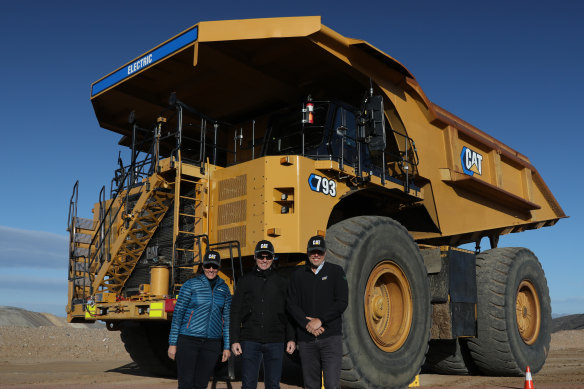
Australia’s largest miner, BHP, is about to test run heavy-haul trucks with electric motors charged by renewable power in a bid to slash fossil fuel use that accounts for 40 per cent of its carbon emissions.
These huge ore trucks run 24 hours a day, burn vast reservoirs of diesel and are ubiquitous across Australia’s open-pit mines.
James Agar, BHP’s group procurement officer, is charged with cutting the company’s 40 per cent diesel emissions footprint. To do that, he needs to electrify its fleet of 650 heavy-haul trucks, weighing in at about 20 to 25 tonnes each, that currently run on polluting fossil fuels.

Caterpillar and BHP are developing electrical heavy-haul trucks to use in its mines. From left: BHP’s Anna Wiley, Mark Pickett and James Agar.Credit:
The vehicles, with tyres taller than the average person, are the size of a modest two-storey house and carry ore loads between 220 and 400 tonnes. The really colossal trucks mainly operate in BHP and Rio Tinto’s joint Escondida copper mine in Chile.
“We put a target out there that we will be net-zero by 2050 and will be 30 per cent reduced by 2030,” Agar said.
BHP’s Scope 1 and 2 emissions are primarily generated by its operations, and roughly break down to 40 per cent from power use, 40 per cent from diesel fuel and 20 per cent from areas such as fugitive emissions from its coal operations.
The miner has partnered with industrial equipment manufacturers, US-based Caterpillar and Japan’s Komatsu, to develop electric versions of the heavy haulers, pulling out the engine and replacing it with an electric motor and eight-tonne battery.
“Three or four years ago ... there was a fairly dogmatic view in some of these industries around defending the diesel engine and all of the decades of IP that had gone into refining, improving and optimising them,” Agar said.
“But the way we saw demand playing out in the future and the types of trucks that we wanted operating on our sites did spark a real sense of innovation and collaboration through our supply chains,” he said.









 Add Category
Add Category